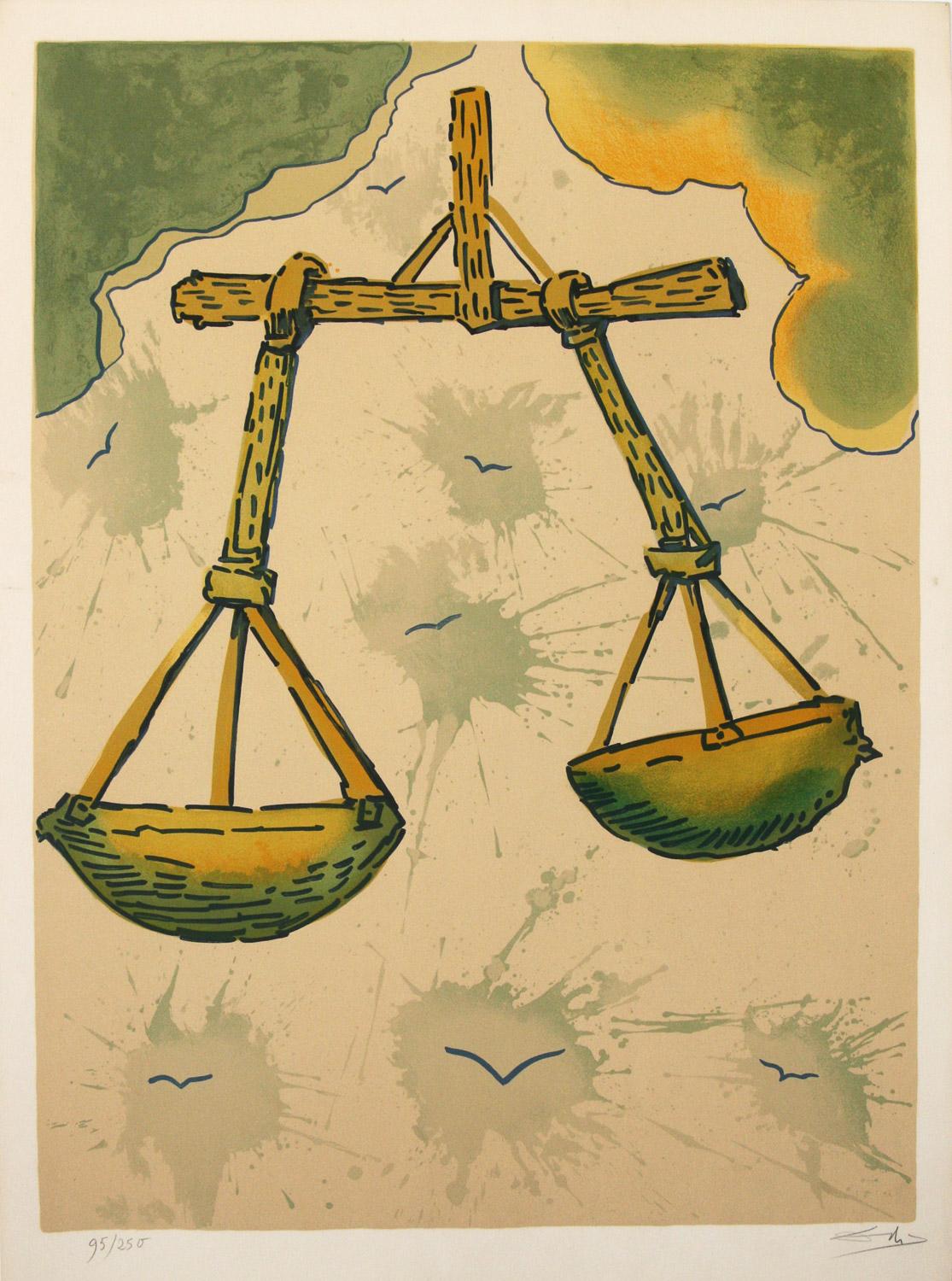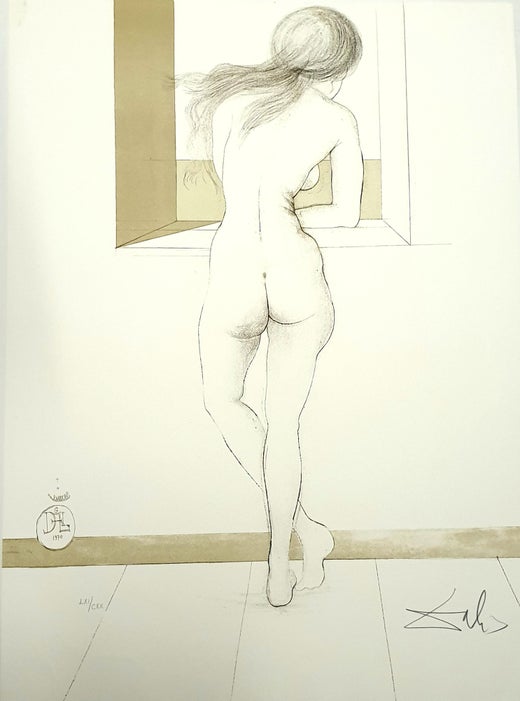Salvador DalíBullfight No. 5 original lithograph by Salvador Dali1966
1966
About the Item
- Creator:Salvador Dalí (1904 - 1989, Spanish)
- Creation Year:1966
- Dimensions:Height: 30 in (76.2 cm)Width: 22 in (55.88 cm)
- Medium:
- Movement & Style:
- Period:
- Condition:
- Gallery Location:Paonia, CO
- Reference Number:1stDibs: LU78034827552
Salvador Dalí
Instantly recognizable by his waxed, upturned mustache, the flamboyant Salvador Dalí is one of modern art’s most distinctive figures. He is also one of the icons of the 20-century avant-garde Surrealist movement, whose dreamlike images, drawn from the depths of the unconscious, he deployed in paintings, sculptures, prints and fashion, as well as in film collaborations with Luis Buñuel and Alfred Hitchcock.
Dalí was born in Figueres, Catalonia, and even as a youngster, displayed the sensitivity, sharp perception and vivid imagination that would later define his artworks. In these, he conjured childhood memories and employed religious symbols and Freudian imagery like staircases, keys and dripping candles to create unexpected, often shocking pieces.
Dalí's use of hyperrealism in conveying Surrealist symbols and concepts that subvert accepted notions of reality is epitomized in what is perhaps his most recognizable painting, The Persistence of Memory (1931), in which he depicts the fluidity of time through melting clocks, their forms inspired by Camembert cheese melting in the sun. His artistic genius, eccentric personality and eternal quest for fame made him a global celebrity.
“Each morning when I awake, I experience again a supreme pleasure,” he once said. “That of being Salvador Dalí.”
Find original Salvador Dalí paintings, prints, sculptures and other works on 1stDibs.
- ShippingRetrieving quote...Ships From: Paonia, CO
- Return PolicyA return for this item may be initiated within 7 days of delivery.
- Let Us Make Man in our Image and Likeness Dali lithograph Biblia Sacra 1964By Salvador DalíLocated in Paonia, COLet Us Make Man in our Image and Likeness shows God lying on his back facing upwards with his left hand raised, two fingers pointing upwards in the midst of creating man repres...Category
1960s Surrealist Abstract Prints
MaterialsLithograph
- Signs of The Zodiac, Libra by Salvador DaliBy Salvador DalíLocated in Paonia, COSigns of the Zodiac is a series of 12 limited edition lithographs by Salvador Dali. This original hand signed lithograph is Libra, the seventh astrological sign in the Zodiac and is...Category
1960s Surrealist Abstract Prints
MaterialsLithograph
- Moderna Museet ( the Red Model ) Oct -Nov ’67 original poster by Magritte framedBy (after) René MagritteLocated in Paonia, COModerna Museet ( the Red Model ) Oct -Nov ’67 is an original poster for an exhibit of works by renowned surrealist painter, Rene Magritte ( 1898 – 1967 ). It was held at the Moder...Category
1960s Surrealist Abstract Prints
MaterialsLithograph
- Behold The Virgin Shall Conceive from Biblia Sacra by Salvador DaliBy Salvador DalíLocated in Paonia, COBehold The Virgin Shall Conceive is a 1967 colored lithograph signed in the plate from the original gouache and is printed on heavy rag paper From Salvador Dali’s five volume Biblia ...Category
1960s Surrealist Figurative Prints
MaterialsLithograph
- Biblia Sacra Man and Woman in the Garden of Pleasure original lithograph SalvadoBy Salvador DalíLocated in Paonia, COMan and Woman in the Garden of Pleasure is an original lithograph from Salvador Dali’s five volume Biblia Sacra Suite published in Rome by Riz...Category
1660s Surrealist Abstract Prints
MaterialsLithograph
- The He-Goats Of The Wild She-Goats On The Face Of The Earth Biblia Sacra by DaliBy Salvador DalíLocated in Paonia, COThe He-Goats Of The Wild She-Goats On The Face Of The Earth shows the angel Gabriel hovering on the left side of a tornado. He has come to help Daniel interpret his vision about ...Category
1960s Surrealist Abstract Prints
MaterialsLithograph
- French Abstract Surrealist Color Lithograph Andre MassonBy André MassonLocated in Surfside, FLPublished Benincasa Carmine. Edizioni SEAT, Torino, Italy. Offset directly from the original plates. Limited edition. This is not hand signed or numbered. Signature in the printing p...Category
20th Century Surrealist Abstract Prints
MaterialsLithograph, Offset
- French Abstract Surrealist Color Lithograph Andre MassonBy André MassonLocated in Surfside, FLPublished Benincasa Carmine. Edizioni SEAT, Torino, Italy. Offset directly from the original plates. Limited edition. This is not hand signed or numbered. Signature in the printing p...Category
20th Century Surrealist Abstract Prints
MaterialsLithograph, Offset
- French Abstract Surrealist Color Lithograph Andre MassonBy André MassonLocated in Surfside, FLPublished Benincasa Carmine. Edizioni SEAT, Torino, Italy. Offset directly from the original plates. Limited edition. This is not hand signed or numbered. Signature in the printing plate. Size is of the full sheet. André-Aimé-René Masson (4 January 1896 – 28 October 1987) was a French artist. Masson was born in Balagny-sur-Thérain, Oise, but when he was eight his father's work took the family first briefly to Lille and then to Brussels. He began his study of art at the age of eleven at the Académie Royale des Beaux-Arts in Brussels, under the guidance of Constant Montald, and later he studied in Paris. He fought for France during World War I and was seriously injured. His early works display an interest in cubism. He later became associated with surrealism, and he was one of the most enthusiastic employers of automatic drawing, making a number of automatic works in pen and ink. Masson would often force himself to work under strict conditions, for example, after long periods of time without food or sleep, or under the influence of drugs. He believed forcing himself into a reduced state of consciousness would help his art be free from rational control, and hence get closer to the workings of his subconscious mind. Masson experimented with altered states of consciousness with artists such as Antonin Artaud, Michel Leiris, Joan Miro, Georges Bataille, Jean Dubuffet, and Georges Malkine, who were neighbors of his studio in Paris. From around 1926 he experimented by throwing sand and glue onto canvas and making oil paintings based around the shapes that formed. By the end of the 1920s, however, he was finding automatic drawing rather restricting, and he left the surrealist movement and turned instead to a more structured style, often producing works with a violent or erotic theme, and making a number of paintings in reaction to the Spanish Civil War (he associated once more with the surrealists at the end of the 1930s). Under the German occupation of France during World War II, his work was condemned by the Nazis as degenerate. With the assistance of Varian Fry in Marseille, Masson escaped the Nazi regime on a ship to the French island of Martinique from where he went on to the United States. Upon arrival in New York City, U.S. customs officials inspecting Masson's luggage found a cache of his erotic drawings. Denouncing them as pornographic, they ripped them up before the artist's eyes. Living in New Preston, Connecticut his work became an important influence on American abstract expressionists, In particular Arshile Gorky drew on it, as did Jackson Pollock and Mark Rothko. Following the war, he returned to France and settled in Aix-en-Provence where he painted a number of landscapes. Masson drew the cover of the first issue of Georges Bataille's review, Acéphale, in 1936, and participated in all its issues until 1939. His brother-in-law, the psychoanalyst Jacques Lacan...Category
20th Century Surrealist Abstract Prints
MaterialsLithograph, Offset
- LA FOLLE AU PIMENT RAGEURBy Joan MiróLocated in Aventura, FLHand signed and numbered lithograph in colors on Arches paper. Mourlot 1025. Published by Maeght Éditeur, Paris. Edition of 27/30. Artwork size 91.375 x 47.875 inches. Custom framed ...Category
1970s Surrealist Abstract Prints
MaterialsPaper, Lithograph
- Terres Grand de Feu (one plate from Artigas) (~50% OFF LIST PRICE, LIMITED TIME)By Joan MiróLocated in Kansas City, MOJoan Miro Terres Grand de Feu (one plate from Artigas) Medium: Original lithograph Size: 14.1875 x 19.625 in Year: 1956 Edition: 1,500 Unsigned Printed text on verso as issued Portf...Category
1950s Surrealist Abstract Prints
MaterialsLithograph
- French Abstract Surrealist Color Lithograph Andre MassonBy André MassonLocated in Surfside, FLPublished Benincasa Carmine. Edizioni SEAT, Torino, Italy. Offset directly from the original plates. Limited edition. This is not hand signed or numbered. Signature in the printing plate. Size is of the full sheet. André-Aimé-René Masson (4 January 1896 – 28 October 1987) was a French artist. Masson was born in Balagny-sur-Thérain, Oise, but when he was eight his father's work took the family first briefly to Lille and then to Brussels. He began his study of art at the age of eleven at the Académie Royale des Beaux-Arts in Brussels, under the guidance of Constant Montald, and later he studied in Paris. He fought for France during World War I and was seriously injured. His early works display an interest in cubism. He later became associated with surrealism, and he was one of the most enthusiastic employers of automatic drawing, making a number of automatic works in pen and ink. Masson would often force himself to work under strict conditions, for example, after long periods of time without food or sleep, or under the influence of drugs. He believed forcing himself into a reduced state of consciousness would help his art be free from rational control, and hence get closer to the workings of his subconscious mind. Masson experimented with altered states of consciousness with artists such as Antonin Artaud, Michel Leiris, Joan Miro, Georges Bataille, Jean Dubuffet, and Georges Malkine, who were neighbors of his studio in Paris. From around 1926 he experimented by throwing sand and glue onto canvas and making oil paintings based around the shapes that formed. By the end of the 1920s, however, he was finding automatic drawing rather restricting, and he left the surrealist movement and turned instead to a more structured style, often producing works with a violent or erotic theme, and making a number of paintings in reaction to the Spanish Civil War (he associated once more with the surrealists at the end of the 1930s). Under the German occupation of France during World War II, his work was condemned by the Nazis as degenerate. With the assistance of Varian Fry in Marseille, Masson escaped the Nazi regime on a ship to the French island of Martinique from where he went on to the United States. Upon arrival in New York City, U.S. customs officials inspecting Masson's luggage found a cache of his erotic drawings. Denouncing them as pornographic, they ripped them up before the artist's eyes. Living in New Preston, Connecticut his work became an important influence on American abstract expressionists, In particular Arshile Gorky drew on it, as did Jackson Pollock and Mark Rothko. Following the war, he returned to France and settled in Aix-en-Provence where he painted a number of landscapes. Masson drew the cover of the first issue of Georges Bataille's review, Acéphale, in 1936, and participated in all its issues until 1939. His brother-in-law, the psychoanalyst Jacques Lacan...Category
20th Century Surrealist Abstract Prints
MaterialsLithograph, Offset






